LI 2 Report: Learning Disabilities: Dyslexia, Dyscalculia, Dysgraphia
VerifiedAdded on 2022/08/16
|6
|1236
|17
Report
AI Summary
This report, titled "LI 2: Learning Issues," examines three specific learning disabilities: Dyslexia, Dyscalculia, and Dysgraphia. It defines each condition, detailing the symptoms associated with each at different life stages, from childhood through adulthood. The report then explores various strategies and interventions for each learning disability. For Dyslexia, it highlights educational approaches and techniques like using word processing programs and speech recognition software. For Dyscalculia, it discusses repeated practice, segmenting course material, and the use of tools like CogniFit. Finally, for Dysgraphia, the report suggests using word processors, providing oral exams, and allowing the use of note-takers. The report concludes with a comprehensive list of references supporting the information presented.
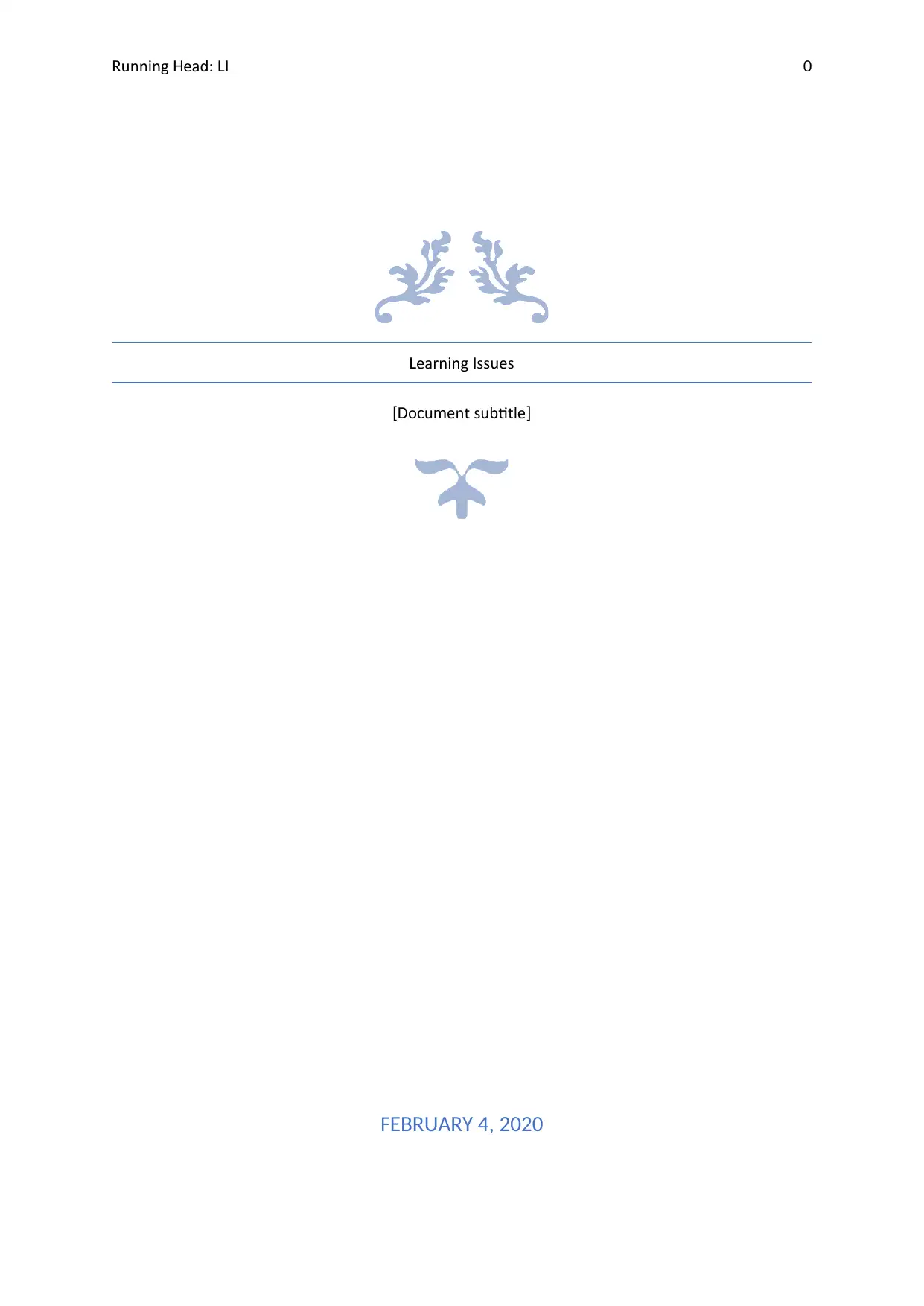
unning eadR H : LI 0
earning ssuesL I
o u ent subtitle[D c m ]
FEBRUARY 4, 2020
earning ssuesL I
o u ent subtitle[D c m ]
FEBRUARY 4, 2020
Paraphrase This Document
Need a fresh take? Get an instant paraphrase of this document with our AI Paraphraser
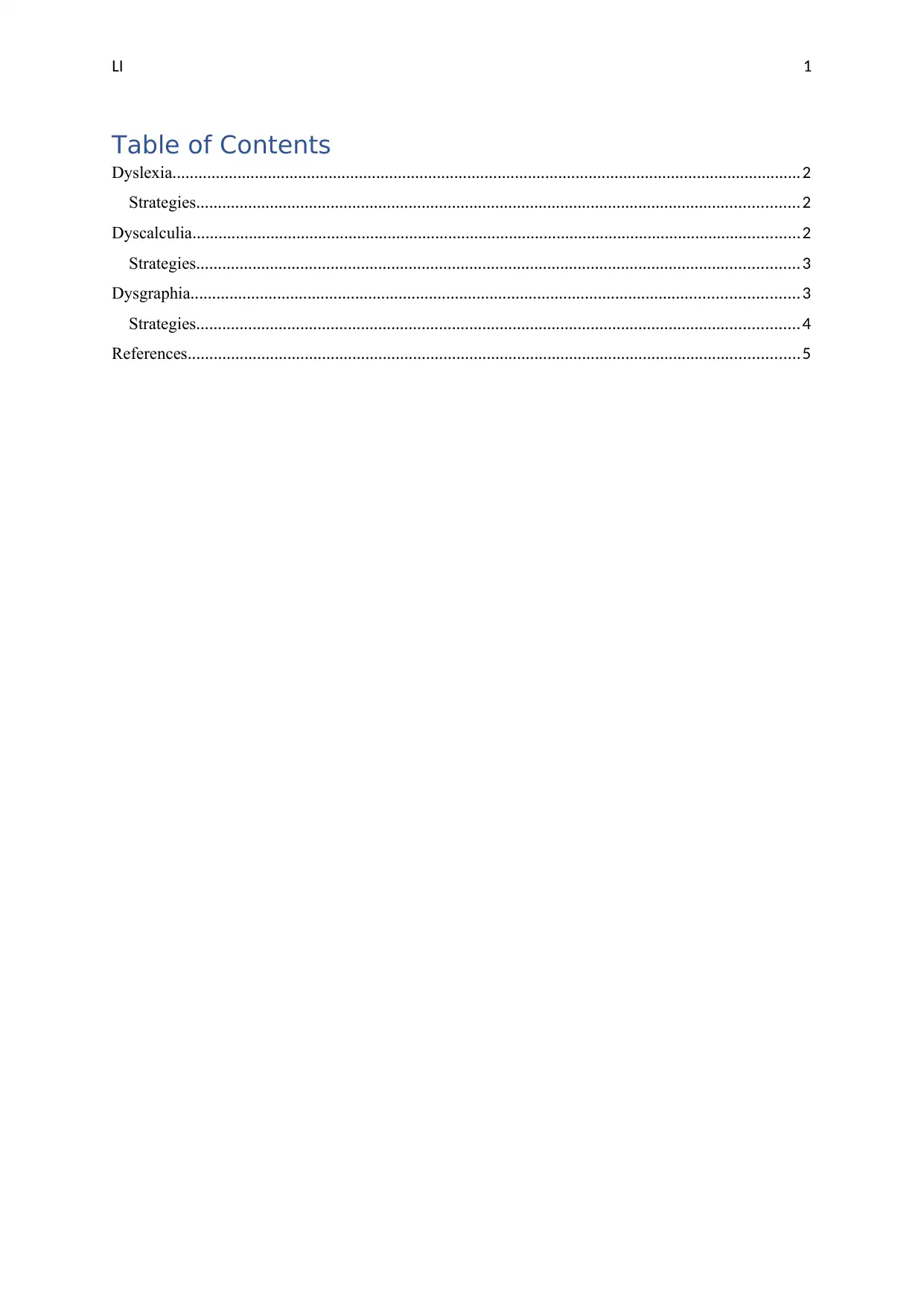
LI 1
Table of Contents
Dyslexia.................................................................................................................................................2
Strategies...........................................................................................................................................2
Dyscalculia............................................................................................................................................2
Strategies...........................................................................................................................................3
Dysgraphia............................................................................................................................................3
Strategies...........................................................................................................................................4
References.............................................................................................................................................5
Table of Contents
Dyslexia.................................................................................................................................................2
Strategies...........................................................................................................................................2
Dyscalculia............................................................................................................................................2
Strategies...........................................................................................................................................3
Dysgraphia............................................................................................................................................3
Strategies...........................................................................................................................................4
References.............................................................................................................................................5
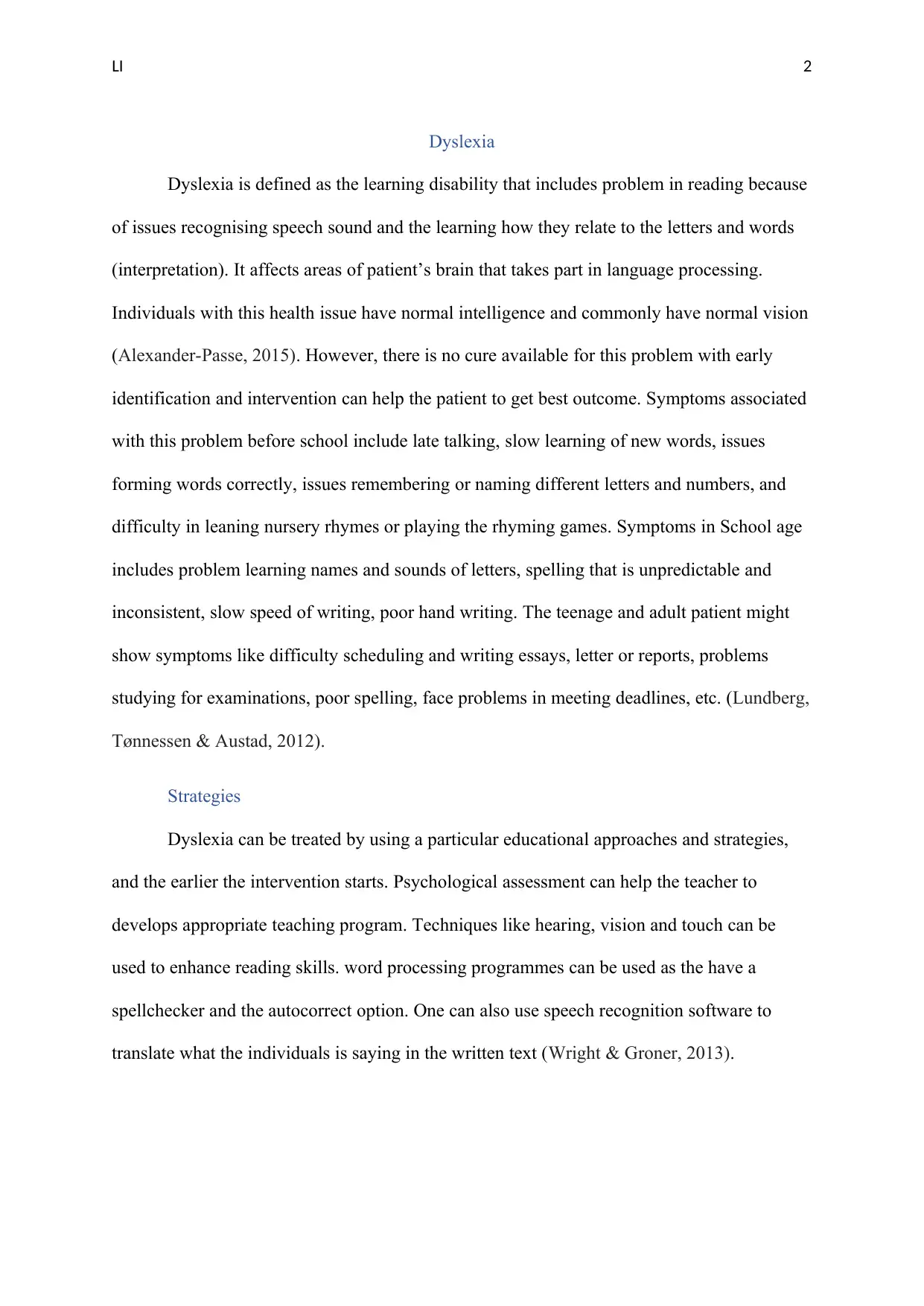
LI 2
Dyslexia
Dyslexia is defined as the learning disability that includes problem in reading because
of issues recognising speech sound and the learning how they relate to the letters and words
(interpretation). It affects areas of patient’s brain that takes part in language processing.
Individuals with this health issue have normal intelligence and commonly have normal vision
(Alexander-Passe, 2015). However, there is no cure available for this problem with early
identification and intervention can help the patient to get best outcome. Symptoms associated
with this problem before school include late talking, slow learning of new words, issues
forming words correctly, issues remembering or naming different letters and numbers, and
difficulty in leaning nursery rhymes or playing the rhyming games. Symptoms in School age
includes problem learning names and sounds of letters, spelling that is unpredictable and
inconsistent, slow speed of writing, poor hand writing. The teenage and adult patient might
show symptoms like difficulty scheduling and writing essays, letter or reports, problems
studying for examinations, poor spelling, face problems in meeting deadlines, etc. (Lundberg,
Tønnessen & Austad, 2012).
Strategies
Dyslexia can be treated by using a particular educational approaches and strategies,
and the earlier the intervention starts. Psychological assessment can help the teacher to
develops appropriate teaching program. Techniques like hearing, vision and touch can be
used to enhance reading skills. word processing programmes can be used as the have a
spellchecker and the autocorrect option. One can also use speech recognition software to
translate what the individuals is saying in the written text (Wright & Groner, 2013).
Dyslexia
Dyslexia is defined as the learning disability that includes problem in reading because
of issues recognising speech sound and the learning how they relate to the letters and words
(interpretation). It affects areas of patient’s brain that takes part in language processing.
Individuals with this health issue have normal intelligence and commonly have normal vision
(Alexander-Passe, 2015). However, there is no cure available for this problem with early
identification and intervention can help the patient to get best outcome. Symptoms associated
with this problem before school include late talking, slow learning of new words, issues
forming words correctly, issues remembering or naming different letters and numbers, and
difficulty in leaning nursery rhymes or playing the rhyming games. Symptoms in School age
includes problem learning names and sounds of letters, spelling that is unpredictable and
inconsistent, slow speed of writing, poor hand writing. The teenage and adult patient might
show symptoms like difficulty scheduling and writing essays, letter or reports, problems
studying for examinations, poor spelling, face problems in meeting deadlines, etc. (Lundberg,
Tønnessen & Austad, 2012).
Strategies
Dyslexia can be treated by using a particular educational approaches and strategies,
and the earlier the intervention starts. Psychological assessment can help the teacher to
develops appropriate teaching program. Techniques like hearing, vision and touch can be
used to enhance reading skills. word processing programmes can be used as the have a
spellchecker and the autocorrect option. One can also use speech recognition software to
translate what the individuals is saying in the written text (Wright & Groner, 2013).
⊘ This is a preview!⊘
Do you want full access?
Subscribe today to unlock all pages.

Trusted by 1+ million students worldwide
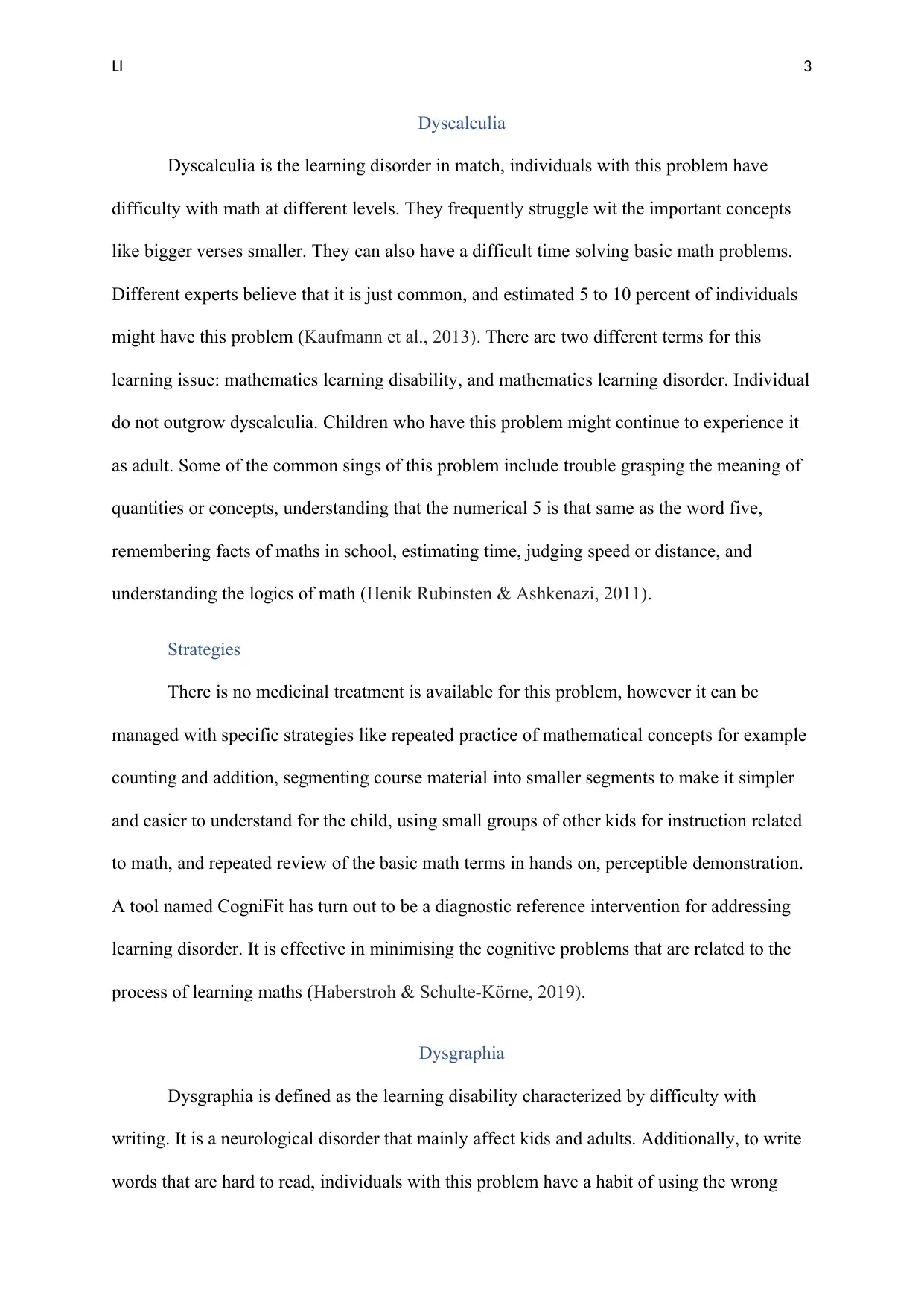
LI 3
Dyscalculia
Dyscalculia is the learning disorder in match, individuals with this problem have
difficulty with math at different levels. They frequently struggle wit the important concepts
like bigger verses smaller. They can also have a difficult time solving basic math problems.
Different experts believe that it is just common, and estimated 5 to 10 percent of individuals
might have this problem (Kaufmann et al., 2013). There are two different terms for this
learning issue: mathematics learning disability, and mathematics learning disorder. Individual
do not outgrow dyscalculia. Children who have this problem might continue to experience it
as adult. Some of the common sings of this problem include trouble grasping the meaning of
quantities or concepts, understanding that the numerical 5 is that same as the word five,
remembering facts of maths in school, estimating time, judging speed or distance, and
understanding the logics of math (Henik Rubinsten & Ashkenazi, 2011).
Strategies
There is no medicinal treatment is available for this problem, however it can be
managed with specific strategies like repeated practice of mathematical concepts for example
counting and addition, segmenting course material into smaller segments to make it simpler
and easier to understand for the child, using small groups of other kids for instruction related
to math, and repeated review of the basic math terms in hands on, perceptible demonstration.
A tool named CogniFit has turn out to be a diagnostic reference intervention for addressing
learning disorder. It is effective in minimising the cognitive problems that are related to the
process of learning maths (Haberstroh & Schulte-Körne, 2019).
Dysgraphia
Dysgraphia is defined as the learning disability characterized by difficulty with
writing. It is a neurological disorder that mainly affect kids and adults. Additionally, to write
words that are hard to read, individuals with this problem have a habit of using the wrong
Dyscalculia
Dyscalculia is the learning disorder in match, individuals with this problem have
difficulty with math at different levels. They frequently struggle wit the important concepts
like bigger verses smaller. They can also have a difficult time solving basic math problems.
Different experts believe that it is just common, and estimated 5 to 10 percent of individuals
might have this problem (Kaufmann et al., 2013). There are two different terms for this
learning issue: mathematics learning disability, and mathematics learning disorder. Individual
do not outgrow dyscalculia. Children who have this problem might continue to experience it
as adult. Some of the common sings of this problem include trouble grasping the meaning of
quantities or concepts, understanding that the numerical 5 is that same as the word five,
remembering facts of maths in school, estimating time, judging speed or distance, and
understanding the logics of math (Henik Rubinsten & Ashkenazi, 2011).
Strategies
There is no medicinal treatment is available for this problem, however it can be
managed with specific strategies like repeated practice of mathematical concepts for example
counting and addition, segmenting course material into smaller segments to make it simpler
and easier to understand for the child, using small groups of other kids for instruction related
to math, and repeated review of the basic math terms in hands on, perceptible demonstration.
A tool named CogniFit has turn out to be a diagnostic reference intervention for addressing
learning disorder. It is effective in minimising the cognitive problems that are related to the
process of learning maths (Haberstroh & Schulte-Körne, 2019).
Dysgraphia
Dysgraphia is defined as the learning disability characterized by difficulty with
writing. It is a neurological disorder that mainly affect kids and adults. Additionally, to write
words that are hard to read, individuals with this problem have a habit of using the wrong
Paraphrase This Document
Need a fresh take? Get an instant paraphrase of this document with our AI Paraphraser
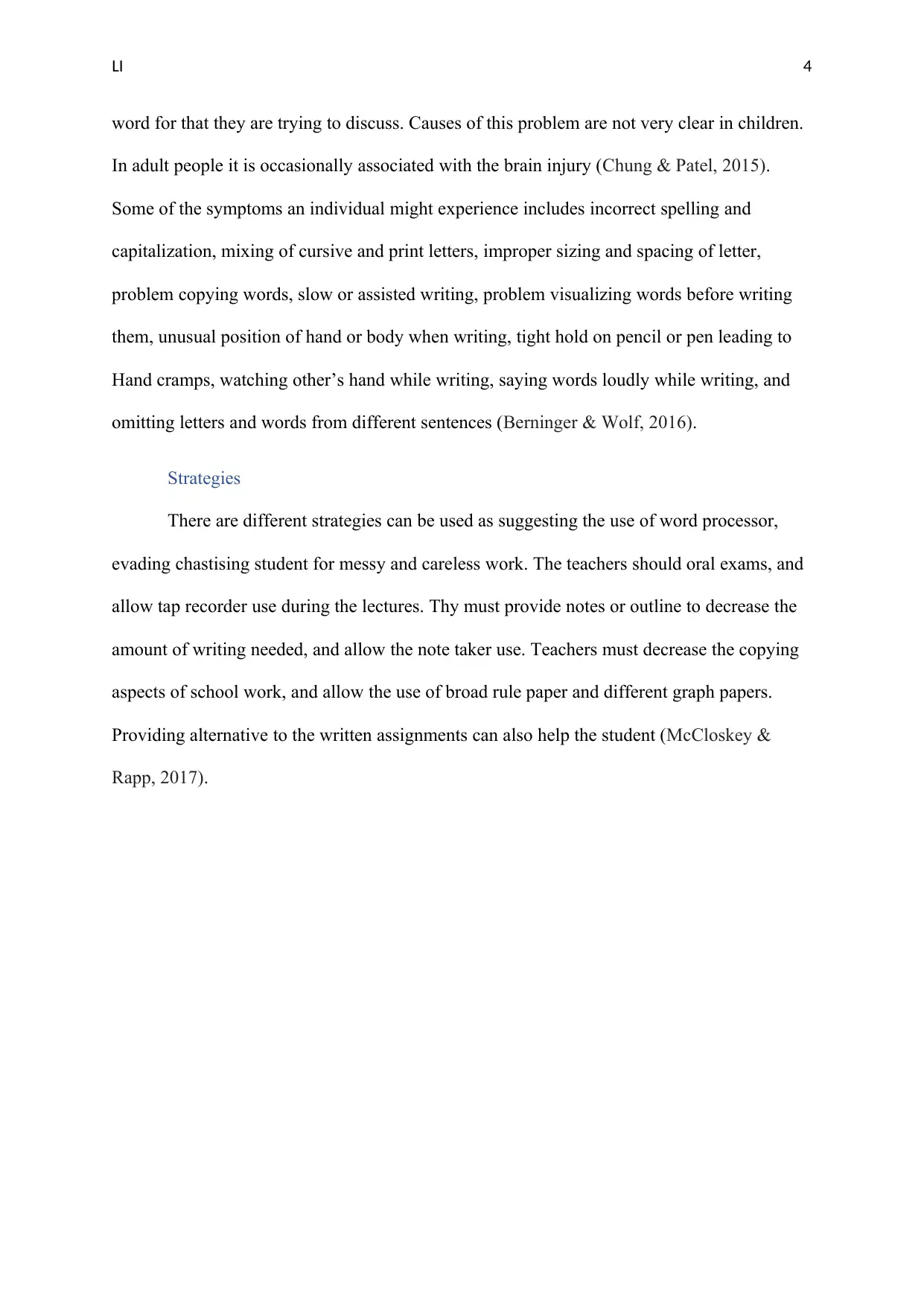
LI 4
word for that they are trying to discuss. Causes of this problem are not very clear in children.
In adult people it is occasionally associated with the brain injury (Chung & Patel, 2015).
Some of the symptoms an individual might experience includes incorrect spelling and
capitalization, mixing of cursive and print letters, improper sizing and spacing of letter,
problem copying words, slow or assisted writing, problem visualizing words before writing
them, unusual position of hand or body when writing, tight hold on pencil or pen leading to
Hand cramps, watching other’s hand while writing, saying words loudly while writing, and
omitting letters and words from different sentences (Berninger & Wolf, 2016).
Strategies
There are different strategies can be used as suggesting the use of word processor,
evading chastising student for messy and careless work. The teachers should oral exams, and
allow tap recorder use during the lectures. Thy must provide notes or outline to decrease the
amount of writing needed, and allow the note taker use. Teachers must decrease the copying
aspects of school work, and allow the use of broad rule paper and different graph papers.
Providing alternative to the written assignments can also help the student (McCloskey &
Rapp, 2017).
word for that they are trying to discuss. Causes of this problem are not very clear in children.
In adult people it is occasionally associated with the brain injury (Chung & Patel, 2015).
Some of the symptoms an individual might experience includes incorrect spelling and
capitalization, mixing of cursive and print letters, improper sizing and spacing of letter,
problem copying words, slow or assisted writing, problem visualizing words before writing
them, unusual position of hand or body when writing, tight hold on pencil or pen leading to
Hand cramps, watching other’s hand while writing, saying words loudly while writing, and
omitting letters and words from different sentences (Berninger & Wolf, 2016).
Strategies
There are different strategies can be used as suggesting the use of word processor,
evading chastising student for messy and careless work. The teachers should oral exams, and
allow tap recorder use during the lectures. Thy must provide notes or outline to decrease the
amount of writing needed, and allow the note taker use. Teachers must decrease the copying
aspects of school work, and allow the use of broad rule paper and different graph papers.
Providing alternative to the written assignments can also help the student (McCloskey &
Rapp, 2017).
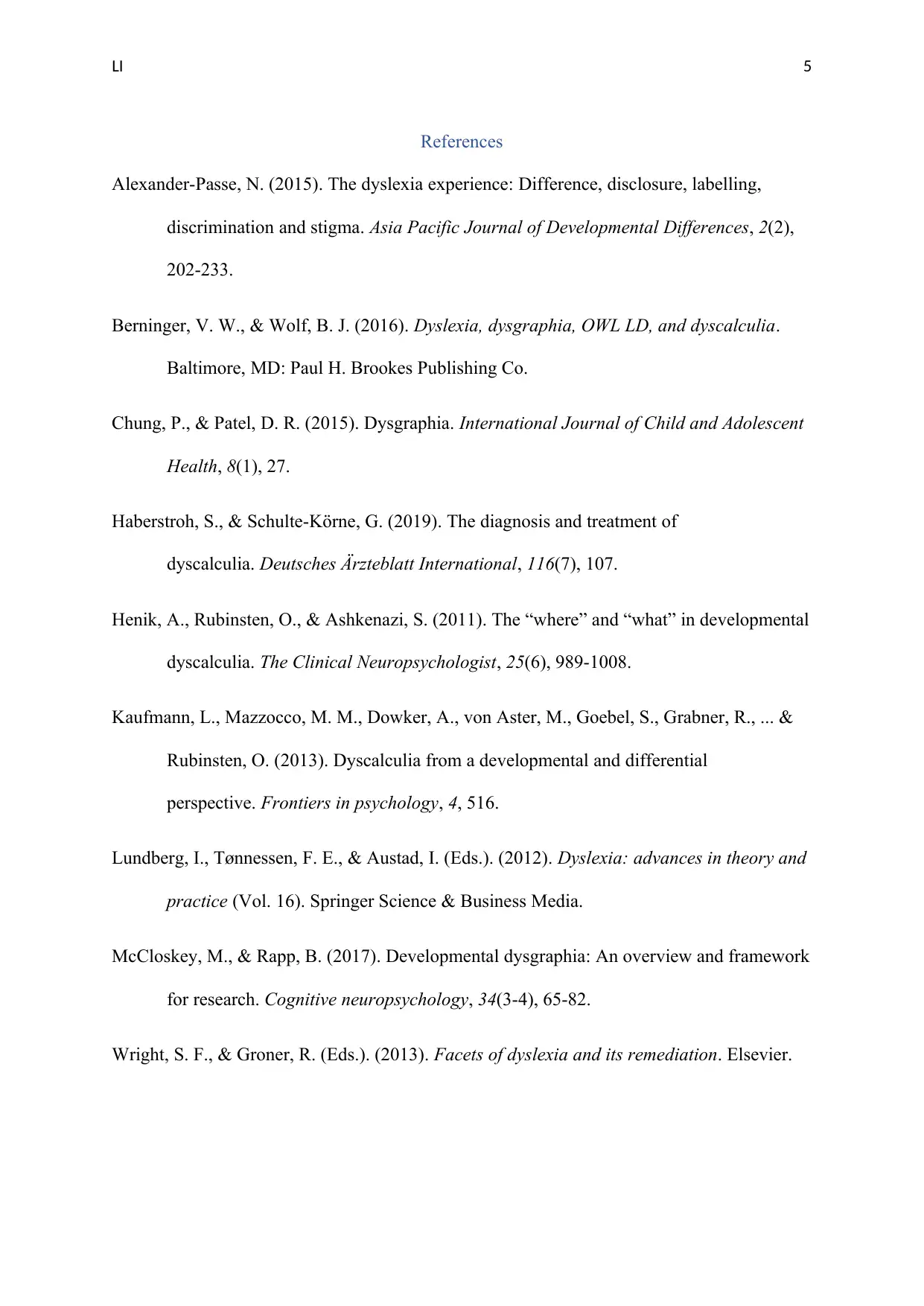
LI 5
References
Alexander-Passe, N. (2015). The dyslexia experience: Difference, disclosure, labelling,
discrimination and stigma. Asia Pacific Journal of Developmental Differences, 2(2),
202-233.
Berninger, V. W., & Wolf, B. J. (2016). Dyslexia, dysgraphia, OWL LD, and dyscalculia.
Baltimore, MD: Paul H. Brookes Publishing Co.
Chung, P., & Patel, D. R. (2015). Dysgraphia. International Journal of Child and Adolescent
Health, 8(1), 27.
Haberstroh, S., & Schulte-Körne, G. (2019). The diagnosis and treatment of
dyscalculia. Deutsches Ärzteblatt International, 116(7), 107.
Henik, A., Rubinsten, O., & Ashkenazi, S. (2011). The “where” and “what” in developmental
dyscalculia. The Clinical Neuropsychologist, 25(6), 989-1008.
Kaufmann, L., Mazzocco, M. M., Dowker, A., von Aster, M., Goebel, S., Grabner, R., ... &
Rubinsten, O. (2013). Dyscalculia from a developmental and differential
perspective. Frontiers in psychology, 4, 516.
Lundberg, I., Tønnessen, F. E., & Austad, I. (Eds.). (2012). Dyslexia: advances in theory and
practice (Vol. 16). Springer Science & Business Media.
McCloskey, M., & Rapp, B. (2017). Developmental dysgraphia: An overview and framework
for research. Cognitive neuropsychology, 34(3-4), 65-82.
Wright, S. F., & Groner, R. (Eds.). (2013). Facets of dyslexia and its remediation. Elsevier.
References
Alexander-Passe, N. (2015). The dyslexia experience: Difference, disclosure, labelling,
discrimination and stigma. Asia Pacific Journal of Developmental Differences, 2(2),
202-233.
Berninger, V. W., & Wolf, B. J. (2016). Dyslexia, dysgraphia, OWL LD, and dyscalculia.
Baltimore, MD: Paul H. Brookes Publishing Co.
Chung, P., & Patel, D. R. (2015). Dysgraphia. International Journal of Child and Adolescent
Health, 8(1), 27.
Haberstroh, S., & Schulte-Körne, G. (2019). The diagnosis and treatment of
dyscalculia. Deutsches Ärzteblatt International, 116(7), 107.
Henik, A., Rubinsten, O., & Ashkenazi, S. (2011). The “where” and “what” in developmental
dyscalculia. The Clinical Neuropsychologist, 25(6), 989-1008.
Kaufmann, L., Mazzocco, M. M., Dowker, A., von Aster, M., Goebel, S., Grabner, R., ... &
Rubinsten, O. (2013). Dyscalculia from a developmental and differential
perspective. Frontiers in psychology, 4, 516.
Lundberg, I., Tønnessen, F. E., & Austad, I. (Eds.). (2012). Dyslexia: advances in theory and
practice (Vol. 16). Springer Science & Business Media.
McCloskey, M., & Rapp, B. (2017). Developmental dysgraphia: An overview and framework
for research. Cognitive neuropsychology, 34(3-4), 65-82.
Wright, S. F., & Groner, R. (Eds.). (2013). Facets of dyslexia and its remediation. Elsevier.
⊘ This is a preview!⊘
Do you want full access?
Subscribe today to unlock all pages.

Trusted by 1+ million students worldwide
1 out of 6
Related Documents
Your All-in-One AI-Powered Toolkit for Academic Success.
+13062052269
info@desklib.com
Available 24*7 on WhatsApp / Email
![[object Object]](/_next/static/media/star-bottom.7253800d.svg)
Unlock your academic potential
Copyright © 2020–2025 A2Z Services. All Rights Reserved. Developed and managed by ZUCOL.




